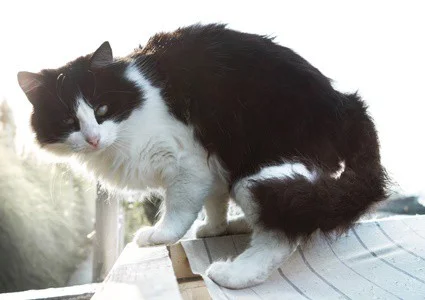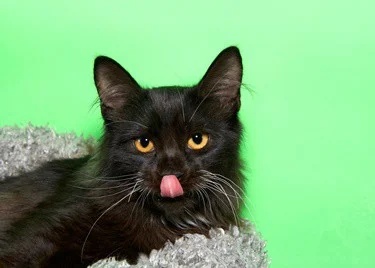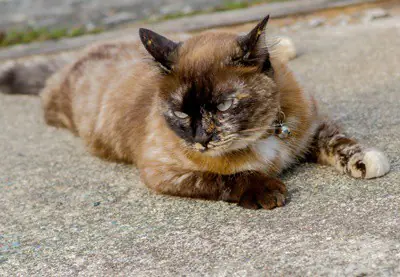Cats’ whiskers (vibrissa) may seem small and inconsequential, but they fulfill several functions. To owners, finding broken whiskers can be a worrying sign, but whisker loss isn’t usually a cause for concern.
Cats’ whiskers usually break off due to natural shedding or rough play. This natural breakage doesn’t cause any physical pain, and their whiskers will grow back. However, if a cat suddenly loses more whiskers than usual, it may be due to a health issue, such as stress, injury, or infection.
Whiskers have various uses that are largely connected to how cats calculate distance and space. Also, cats’ whiskers can give owners an insight into their wellness and emotions.
Is Cat Whisker Breakage Natural?
The whiskers provide cats with information about their surroundings, allowing them to be stealthy, agile, and perceptive. Natural wear and tear mean that it’s natural for cats to break or lose whiskers.
What Are Whiskers?
Scientifically referred to as ‘vibrissa,’ whiskers are integral to many mammalian animals’ anatomy. There are a dozen whiskers on each side of most cats’ cheeks, placed in rows of 4, with 24 whiskers in total.
Aside from the more prominent set on their cheeks, cats have whiskers in the corners of their mouth, nose, chin, eyebrows, and the back of their front legs.
While they may look small, each whisker comprises tiny tactile receptors called mechanoreceptors. These are responsible for handling information about mechanical pressure. These receptors are located along their fur and whiskers, increasing their sensitivity to the world around them.
The roots of whiskers have blood vessels and nerve receptors. This allows information to be picked up by the whiskers and sent straight to the brain, giving cats their lightning-fast reflexes.
What Are Whiskers Made Of?
Cats’ whiskers are made of keratin, which makes up human hair and nails, feathers, horns, and claws. Cats’ fur and nails are made of keratin. For this reason, cats’ whiskers don’t cause pain when they break.
There are no pain receptors on the hair’s shaft, so breaking whiskers causes no physical discomfort. Unlike hair, cats’ whiskers have touch receptors and roots containing blood vessels and nerve receptors.
Cat Whisker Functions
Whiskers continue to be an active field of scientific research. We still don’t know much about how they function and their limits on providing tactile information.
Scientists continue to discover what whiskers can do every day. However, they have two main functions: tactile sense and body language.
Tactile Sense
Because of their sensitivity, whiskers can provide a lot of tactile information to cats.
Tactile sensation enables cats to do the following:
Sense Surroundings
Think about the last time you were in the dark and extended your hand. This is how cats use their whiskers to move about in the world.
Like your extended hand, cats use their whiskers to ensure they don’t bump into objects and feel out objects to get where they need to go.
Rather than feel out objects, whiskers pick up air currents. Sure, humans feeling about in the dark can be a chaotic affair. However, cats can maintain their stealth by feeling air rather than objects.
This ability to sense air currents is why cats react to things that humans cannot see. Likewise, this is how blind cats can still move about, seemingly without much difficulty. They have whiskers to rely on and other sensory organs, like hearing and smell.
In studies where animals were temporarily deprived of their sense of whiskers, like this study published in Science Magazine, they were shown to have a lessened ability to sense their surroundings.
These studies show that whiskers are used to locate objects, detect movement, discriminate between different textures, maintain balance, swim, and locate food.

Check Size And Dimensions
One of the popular anecdotes about cats’ whiskers is that cats use them to gauge the size of an opening to see if they can fit. This line of reasoning is often supported by how cat whiskers are the same width as the cat’s body.
However, this information is disputed. According to the New Zealand Veterinary Association, the length of a cat’s whiskers doesn’t change due to the aging process or body size. In other words, whiskers stay the same length, regardless of whether a cat’s width increases or decreases.
However, there’s reason to believe that cats use their whiskers to determine the size of openings. In a study for the Journal for Neuroscience, rats have been determined to use their whiskers to determine opening sizes to within 5-10% level of accuracy.
Maintaining Balance
Because of the placement of their touch receptors, you may think that cats use their whiskers to balance. However, this is untrue as cats’ ability to balance is due to a structure in their inner ear.
A lack of whiskers may affect balance. This isn’t because whiskers are used for balance, but it’s disorienting to cats. As an important sensory organ, having no whiskers may be equivalent to a lost limb. While your limbs aren’t what you use to balance yourself, their absence can be disorienting.
Body Language
Observing how a cat’s whiskers are positioned, along with the rest of its body, can provide insight into a cat’s emotional state.
Here are the common positions that cat whiskers can take:
- Neutral position: Whiskers positioned slightly to the side while relaxed indicates that a cat is happy, contented, and relaxed.
- Pulled forward, fanned out: This is the position of an interested cat. Its mouth will also be closed, with loose lips.
- Slightly back: These are signs of fear, stress, and anxiety. You may notice this in your cat moments before it bolts out of the room in fear.
- Pulled back tightly: The ears will be pulled back as well, and the rest of the cat’s body is likely to be hunched backward, including its tail, to look larger. This position means aggression.
- Sideways to forwards: Whiskers moving sideways to forwards, along with a flattened and tense face, indicates pain.
What is Whisker Fatigue?
Whisker stress happens when they are stimulated too much, and this happens to cats fed meals in small bowls or bowls with high sides.
When eating, the whiskers may brush against the plate or bowl. This is because the whiskers are so sensitive that repeated brushing can cause stress, leading to inappetence in cats.
To solve this issue, you need to ensure that your cat’s food bowl doesn’t brush against its whiskers. There are food bowls available that are designed to avoid whisker fatigue.
What vets can agree on is that a lack of appetite often indicates a health issue. However, if your cat’s appetite problems go away with a new food bowl, then you likely have nothing to worry about.
What Causes Broken Cat Whiskers?
While trimming whiskers is bad for cats and should be avoided, whiskers naturally break off on their own. More often than not, there is no need to worry about broken or shed whiskers.
However, there are some situations where broken whiskers can be a cause for concern:
Playing Rough
This is most common in cats that are young and full of energy. You may notice more broken whiskers in very active cats than cats that spend most of their time sleeping.
You may notice more lost whiskers in younger cats, specifically in cats that are about 11 weeks old. This is the age when kittens are most likely to shed their first whiskers. Additionally, young cats will play rougher and explore their surroundings more often, leading to more broken whiskers.
As long as your cat isn’t exhibiting other symptoms of poor health, like a lack of appetite, sluggishness, aggressiveness, and avoidance, then your young cat or kitten is perfectly healthy.
Natural Shedding
You may notice that your cat sheds fur and whiskers. As stated above, cats’ whiskers are made of the same substance that makes up their fur.
Natural shedding is a common reason why sedentary cats lose their whiskers. Shedding is a normal cause of whisker loss. It is not a cause for concern unless your cat suddenly sheds more whiskers than usual.
Stress
Stress can be one of the most common reasons for abnormal breakage in cats, and it can cause multiple whisker loss in a short amount of time. The loss of whiskers can cause even more stress for your cat because it becomes disoriented and lacks its tactile sense.
Stress is often just the symptom of the problem, but it can have other causes, such as poor diet or sickness. On the other hand, stress can also be related to something other than your cat’s health, like a noisy environment, an addition to the household, or losing someone in the household.

Injury And Trauma
A sudden loss of whiskers can be due to trauma to the area where the whiskers are located. For example, a blow to the cheek can cause the whiskers on that cheek to fall off because the hair follicles located in that area have been damaged.
Cats can heal themselves from physical injury, so whiskers should regrow after the injury has healed.
Infections
Skin infection is a common culprit. One of the most common skin infections is ringworm, which is a type of fungal infection.
Can You Trim A Cat’s Whiskers?
As cats break their whiskers all the time, is it okay if a cat’s whiskers are trimmed? Since they don’t contain pain receptors, the whiskers aren’t painful when broken or clipped. However, that doesn’t mean clipping the whiskers doesn’t cause any ill effects.
Risk of Injury
Cats use their whiskers to feel their way around objects and explore their environment. A sudden absence of whiskers can be disorienting, leading to accidents and increasing the likelihood of physical injury.
Changes in Behavior
Due to disorientation, a loss of whiskers can cause a behavioral change. When whiskers are lost, cats can become avoidant and hide to lessen their feelings of disorientation. Cats may also feel insecure, as they’ll be less confident about moving.
Increased Stress
Feelings of disorientation can be stressful to cats, and any physical injury or trauma can increase the likelihood of stress. This can start a vicious cycle, as stress can lead to the loss of further whiskers.
Cats like to play rough and enjoy exploring the outside world. Just make sure that your cat’s surroundings are comfortable, and ensure that there aren’t places where it would be difficult for a cat to get out of.

